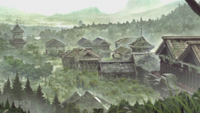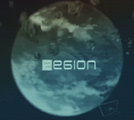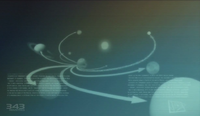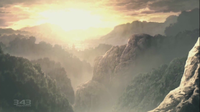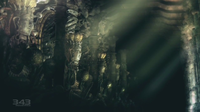Heian: Difference between revisions
From Halopedia, the Halo wiki
(→Ruins) |
m (Reverted edits by 114.74.130.60 (Talk) to last version by Spartansniper450) |
||
| Line 30: | Line 30: | ||
==Ruins== | ==Ruins== | ||
[[File:Planet_ruins.png|thumb|A ruin complex on the planet.]] | [[File:Planet_ruins.png|thumb|A ruin complex on the planet.]] | ||
The origin of the ruins on the planet is a mystery. Their architecture appears to be a mix of a variety of ancient Human architectural styles, including Greco-Roman, Middle Eastern | The origin of the ruins on the planet is a mystery. Their architecture appears to be a mix of a variety of ancient Human architectural styles, including Greco-Roman, Middle Eastern and East Asian styles, with subtle Forerunner themes.<ref name="evo"/> The East Asian themes are clearly among the most prevalent in the structures, including decorations containing dragon-like creatures and statuaries distinctively similar to statues of Buddha. | ||
Most of the buildings have pagoda-like roof structures. Overall, the designs are very ornate and full of carvings. Curiously, the overall scale of most structures is massive; one step in a staircase may be the height of an average human. Some structures seem like a mix of ancient and relatively modern industrial architecture, including a water processing facility with aqueducts and valve systems nigh-identical to those used by humans.<ref name="legends"/> | Most of the buildings have pagoda-like roof structures. Overall, the designs are very ornate and full of carvings. Curiously, the overall scale of most structures is massive; one step in a staircase may be the height of an average human. Some structures seem like a mix of ancient and relatively modern industrial architecture, including a water processing facility with aqueducts and valve systems nigh-identical to those used by humans.<ref name="legends"/> | ||
Revision as of 08:04, April 5, 2010
Heian[1][2] is a world in an unknown system in the Milky Way Galaxy. The planet is terrestrial, with a breathable atmosphere and an Earth-like surface. Meteor showers are common on this world, as thousands of asteroids orbit the planet.[3]
History
At some point predating both Humanity and the Covenant, the planet was inhabited by a yet-unknown civilization. They likely vanished at some point, as their cities were abandoned, yet mostly intact, by the 26th century. It is unknown if this civilization was somehow linked to the Forerunners.
During the Human-Covenant War, the world was the site of an important Covenant logistics base, from which supplies were delivered to the rest of the planets in the system, as well as the entire sector. The UNSC deployed a team of ODSTs and a Spartan on the planet, with the mission to assassinate the Prophet in charge of the operations within the system, in order to stop the Covenant supply chain. They were also tasked with gathering intelligence on the unknown ruins. The team succeeded in their mission, but the Spartan was lost in combat against a Hammer-wielding Brute and an ODST, Checkman, was killed after striking an asteroid in orbit and burned up in the atmosphere after losing control of his SOEIV.[3] The photographs taken by the team were later studied by the Department of Xenoarchaeological Studies at the University of Edinburgh along with the University of Calcutta as a part of an extensive investigation of Forerunner relics.[1]
Ruins
The origin of the ruins on the planet is a mystery. Their architecture appears to be a mix of a variety of ancient Human architectural styles, including Greco-Roman, Middle Eastern and East Asian styles, with subtle Forerunner themes.[1] The East Asian themes are clearly among the most prevalent in the structures, including decorations containing dragon-like creatures and statuaries distinctively similar to statues of Buddha.
Most of the buildings have pagoda-like roof structures. Overall, the designs are very ornate and full of carvings. Curiously, the overall scale of most structures is massive; one step in a staircase may be the height of an average human. Some structures seem like a mix of ancient and relatively modern industrial architecture, including a water processing facility with aqueducts and valve systems nigh-identical to those used by humans.[3]
The ruins also sparked interest within the scientific community. The Department of Xenoarchaeological Studies at the University of Edinburgh, when analyzing the photographs taken by the ODST team from the ruins on Heian, found the obvious elements of Human architecture in the structures puzzling, wondering if their builders borrowed from human architecture or the other way around.[1]
Gallery
Sources
- ^ a b c d Halo: Evolutions - Essential Tales of the Halo Universe - From the Office of Dr. William Arthur Iqbal
- ^ Halo Legends, The Babysitter: "Satellite recon shows radar and magnetic signatures on Heian..."
- ^ a b c Halo Legends, The Babysitter
